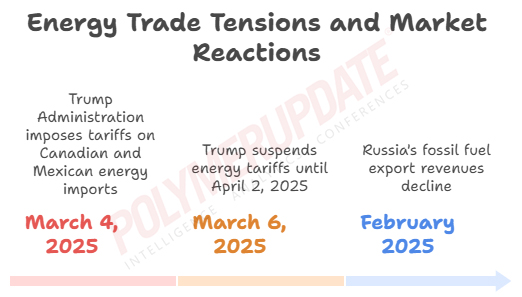Crude oil prices rose by 1 percent on Friday, recovering from a decline of over 1.5 percent the previous day, as Canada threatened to cut supplies to the United States in response to the latter’s announcement of a 10 percent tariff on Canadian energy exports. The United States is flexing its muscles with reciprocal tariffs on imports from across the globe, including key energy suppliers such as Canada and Mexico, while keeping the option of negotiations open to address its trade deficit, estimated at approximately US$ 1 trillion.
Data compiled by Polymerupdate Research showed that benchmark Brent crude futures for near-month delivery on the Intercontinental Exchange (ICE) gained 1 percent, or US$ 0.70 per barrel, to close at US$ 70.58 a barrel on Friday, up from US$ 69.88 a barrel the previous day. On Thursday, Brent crude futures had dropped by 1.51 percent, or US$ 1.07 per barrel, from their closing level of US$ 70.95 a barrel on Wednesday.
Similarly, West Texas Intermediate (WTI) Cushing futures for near-month delivery on the New York Mercantile Exchange (Nymex) ended Friday with a gain of 0.95 percent, or US$ 0.63 per barrel, to settle at US$ 67.18 a barrel, compared to US$ 66.55 a barrel on Thursday. WTI futures had recorded a loss of approximately 2 percent, or US$ 1.33 per barrel, on Thursday, down from US$ 67.68 a barrel on Wednesday. Both energy contracts exhibited significant volatility during the week, reaching periodic highs and lows.
“A rapid shift in global energy and economic fundamentals is driving crude oil price volatility. Oil prices are poised for their first weekly gain in a month, albeit modestly, as the continuous flow of tariff-related news is being offset by concerns surrounding Trump’s Ukraine-Russia ceasefire plan and tightening sanctions on Iran. Meanwhile, the International Energy Agency’s (IEA’s) forecast of reduced global energy demand by 2025 has further weighed on energy prices,” said an analyst with a leading commodities brokerage firm.
 Canada’s supply threat to the US
Canada’s supply threat to the US
Canada, the North American country and a major energy supplier to the United States, challenged U.S. President Donald Trump by threatening to restrict crude oil exports to the world’s largest economy. This move comes in response to Washington’s imposition of import tariffs on Canadian goods. In a strong warning to the United States, Canada’s Energy Minister, Jonathan Wilkinson, suggested that retaliatory measures, including tariffs, were under consideration for imports from the U.S.
“When we talk about non-tariff retaliation, it could involve restricting supply, imposing export duties, or targeting specific sectors such as energy and materials. The scope could even extend to critical minerals, potentially increasing U.S. reliance on China. Everything is on the table,” Wilkinson stated in response to a media query.
On March 4, 2025, the Trump Administration imposed tariffs of 10 percent on oil and gas imports from Canada and 25 percent on those from Mexico. However, on March 6, President Trump announced a suspension of these tariffs until April 2, 2025. Canada and Mexico are critical energy trading partners for the United States, accounting for 70 percent of its crude oil imports in 2022. Research estimates suggest that these energy tariffs could cost approximately US$ 6.5 billion in the first year—US$ 5.2 billion from Canadian imports and US$ 1.3 billion from Mexican imports.
The energy tariffs are expected to raise prices for U.S. consumers, create significant policy uncertainty for U.S. businesses, and adversely impact U.S. exporters, as the stronger dollar would make American exports more expensive. Canada and Mexico are particularly significant for U.S. energy trade; in 2022, Canada alone accounted for 99 percent of U.S. natural gas imports, nearly all of which were delivered via pipeline.
IEA’s oil demand forecasts
The International Energy Agency (IEA) forecasts that global oil demand growth will accelerate to just over 1 million barrels per day (bpd) in 2025, up from 830,000 bpd in 2024, reaching a total of 103.9 million bpd. Asia is expected to account for nearly 60 percent of the gains, led by China, where petrochemical feedstocks will drive the entirety of the demand increase.
Global crude oil supply rose by 240,000 bpd in February, reaching 103.3 million bpd, largely driven by the Organisation of the Petroleum Exporting Countries (OPEC+). Although the actual supply boost from the gradual unwinding of OPEC+ production cuts in April may be less than the nominal 138,000 bpd increase, global oil supply is already trending upward.
WTI Cushing futures declined by approximately US$ 7 per barrel in February and early March, as macroeconomic sentiment weakened amid escalating trade tensions, which have clouded the outlook for oil demand growth. Plans by OPEC+ to unwind voluntary production cuts in April further contributed to expectations of comfortable crude balances in 2025. ICE Brent futures fell by US$ 11 per barrel over the past eight weeks, trading near three-year lows around US$ 70 per barrel.
Macroeconomic conditions underpinning oil demand projections have deteriorated over the past month, primarily due to escalating trade tensions between the United States and multiple other countries. The introduction of new U.S. tariffs, coupled with retaliatory measures, has tilted macroeconomic risks to the downside. Recent oil demand data has been underwhelming, leading to a marginal downgrade in growth estimates for the October–December 2024 and January–March 2025 quarters, now projected at around 1.2 million bpd. Both advanced and developing markets reported lower-than-expected demand during this period.
Russia on edge
The Helsinki-based non-profit think tank specializing in energy research, the Centre for Research on Energy and Clean Air (CREA), reported a 3 percent month-on-month decline in Russia’s monthly fossil fuel export revenues, amounting to EUR 640 million per day. The five largest European Union countries importing Russian fossil fuels collectively paid Russia EUR 1.3 billion for these imports, over half of which were purchases of liquefied natural gas (LNG).
Notably, oil shipments via “shadow fleet” tankers from Russia dropped by 21 percent in February 2025 compared to January 2025. In contrast, oil transported using vessels owned or insured by the Group of Seven (G7+) increased by 15 percent during the same period. This shift indicates that U.S. sanctions imposed by the Office of Foreign Assets Control (OFAC) in January may have had a significant impact on Russian oil flows.
Since the introduction of the oil price cap up to the end of February 2025, strict enforcement of the cap would have reduced Russia’s export revenues by 12 percent, equivalent to EUR 40.4 billion. In February 2025 alone, comprehensive enforcement of the price cap could have cut revenues by approximately EUR 1.2 billion, representing a 12 percent decrease.
DILIP KUMAR JHA
Editor
dilip.jha@polymerupdate.com
